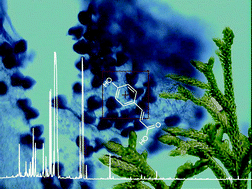Rapid determination of spore chemistry using thermochemolysis gas chromatography-mass spectrometry and micro-Fourier transform infrared spectroscopy
Abstract
Spore chemistry is at the centre of investigations aimed at producing a proxy record of harmful ultraviolet radiation (UV-B) through time. A biochemical proxy is essential owing to an absence of long-term (century or more) instrumental records. Spore cell material contains UV-B absorbing compounds that appear to be synthesised in variable amounts dependent on the ambient UV-B flux. To facilitate these investigations we have developed a rapid method for detecting variations in spore chemistry using combined thermochemolysis ![[double bond, length as m-dash]](https://www.rsc.org/images/entities/char_e001.gif) C absorption band which was exclusive to the pigments. We show increases in micro-FTIR aromatic absorption (1510 cm−1) with altitude that may reflect a chemical response to higher UV-B flux. Our results indicate that rapid chemical analyses of historical spore samples could provide a record ideally suited to investigations of a proxy for stratospheric O3 layer variability and UV-B flux over historical (century to millennia) timescales.
C absorption band which was exclusive to the pigments. We show increases in micro-FTIR aromatic absorption (1510 cm−1) with altitude that may reflect a chemical response to higher UV-B flux. Our results indicate that rapid chemical analyses of historical spore samples could provide a record ideally suited to investigations of a proxy for stratospheric O3 layer variability and UV-B flux over historical (century to millennia) timescales.


 Please wait while we load your content...
Please wait while we load your content...